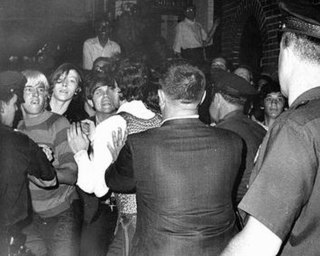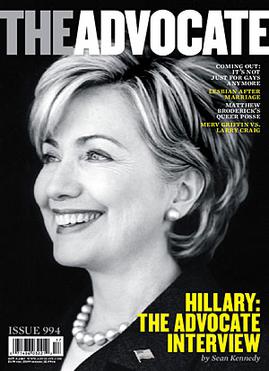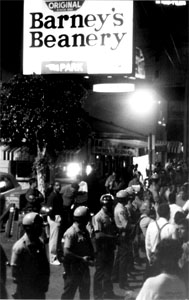Related Research Articles

The Stonewall riots, also known as the Stonewall uprising, Stonewall rebellion, Stonewall revolution, or simply Stonewall, were a series of spontaneous, violent demonstrations against a police raid that took place in the early morning hours of June 28, 1969, at the Stonewall Inn, in the Greenwich Village neighborhood of New York City. Although the demonstrations were not the first time American homosexuals fought back against government-sponsored persecution of sexual minorities, the Stonewall riots marked a new beginning for the gay rights movement in the United States and around the world.

Henry Hay Jr. was an American gay rights activist, communist, and labor advocate. He cofounded the Mattachine Society, the first sustained gay rights group in the United States, as well as the Radical Faeries, a loosely affiliated gay spiritual movement. Hay has been described as "the Founder of the Modern Gay Movement" and "the father of gay liberation".

Radical Faeries are a loosely affiliated worldwide network and countercultural movement seeking to redefine queer consciousness through secular spirituality. Sometimes deemed a form of modern Paganism, the movement also adopts elements from anarchism and environmentalism. Rejecting hetero-imitation, the Radical Faerie movement began during the 1970s sexual revolution among gay men in the United States.

The Advocate is an American LGBT magazine, printed bi-monthly and available by subscription. The Advocate brand also includes a website. Both magazine and website have an editorial focus on news, politics, opinion, and arts and entertainment of interest to lesbians, gay men, bisexuals and transgender (LGBT) people. The magazine, established in 1967, is the oldest and largest LGBT publication in the United States and the only surviving one of its kind that was founded before the 1969 Stonewall riots in Manhattan, an uprising that was a major milestone in the LGBT rights movement. On June 9, 2022, Pride Media was acquired by Equal Entertainment LLC.

Gay Liberation Front (GLF) was the name of several gay liberation groups, the first of which was formed in New York City in 1969, immediately after the Stonewall riots. Similar organizations also formed in the UK, Australia and Canada. The GLF provided a voice for the newly-out and newly radicalized gay community, and a meeting place for a number of activists who would go on to form other groups, such as the Gay Activists Alliance, Gay Youth New York, and Street Transvestite Action Revolutionaries (STAR) in the US. In the UK and Canada, activists also developed a platform for gay liberation and demonstrated for gay rights. Activists from both the US and UK groups would later go on to found or be active in groups including ACT UP, the Lesbian Avengers, Queer Nation, Sisters of Perpetual Indulgence, and Stonewall.

The gay liberation movement was a social and political movement of the late 1960s through the mid-1980s in the Western world, that urged lesbians and gay men to engage in radical direct action, and to counter societal shame with gay pride. In the feminist spirit of the personal being political, the most basic form of activism was an emphasis on coming out to family, friends, and colleagues, and living life as an openly lesbian or gay person.

Morris Kight was an American gay rights pioneer and peace activist. He is considered one of the original founders of the gay and lesbian civil rights movement in the United States.
Lillian Faderman is an American historian whose books on lesbian history and LGBT history have earned critical praise and awards. The New York Times named three of her books on its "Notable Books of the Year" list. In addition, The Guardian named her book, Odd Girls and Twilight Lovers, one of the Top 10 Books of Radical History. She was a professor of English at California State University, Fresno, which bestowed her emeritus status, and a visiting professor at University of California, Los Angeles (UCLA). She retired from academe in 2007. Faderman has been referred to as "the mother of lesbian history" for her groundbreaking research and writings on lesbian culture, literature, and history.
This is a list of notable events in the history of LGBT rights that took place worldwide in the 1950s.
This is a list of notable events in the history of LGBT rights that took place in the 1960s.

The Black Cat Tavern is an LGBT historic site located in the Silver Lake neighborhood of Los Angeles, California. In 1967, it was the site of one of the first demonstrations in the United States protesting police brutality against LGBT people, preceding the Stonewall riots by over two years.

A zap is a form of political direct action that came into use in the 1970s in the United States. Popularized by the early gay liberation group Gay Activists Alliance, a zap was a raucous public demonstration designed to embarrass a public figure or celebrity while calling the attention of both gays and straights to issues of gay rights.
The Patch was an LGBT bar formerly located at 610 W. Pacific Coast Highway in the Los Angeles neighborhood of Wilmington, California. The Patch, along with the Black Cat Tavern, played a pivotal role in the gay rights movement, when, in August 1968, it was one of the first sites where there was open resistance to the constant police harassment of gay establishments and meeting places in Southern California.
The Cloistered Order of Conclaved Knights of Sophisticracy, more commonly known as the Knights of the Clock, was an interracial homophile social club based in Los Angeles, California. The Knights were founded by Merton Bird, an African-American man, and W. Dorr Legg, his white lover. Sources differ as to the founding date of the organization, variously citing it as 1949, 1950, and 1951. Regardless of the exact date, the Knights was one of the earliest gay organizations in the United States, with only the Society for Human Rights, the Veterans Benevolent Association and possibly the Mattachine Society pre-dating it.

Jeanne Córdova was an American writer and supporter of the lesbian and gay rights movement, founder of The Lesbian Tide, and a founder of the West Coast LGBT movement. A former Catholic nun, Córdova was a second-wave feminist lesbian activist and self-described butch.

Although often characterized as apolitical, “Los Angeles has provided the setting for many important chapters in the struggle for gay and lesbian community, visibility, and civil rights." Moreover, Los Angeles' LGBTQ community has historically played a significant role in the development of the entertainment industry.

Stuart Timmons was an American journalist, activist, historian, and award-winning author specializing in LGBT history based in Los Angeles, California. He was the author of The Trouble With Harry Hay: Founder of the Modern Gay Movement and the co-author of Gay L.A.: A History of Sexual Outlaws, Power Politics, and Lipstick Lesbians with Lillian Faderman.

Set the Night on Fire: L.A. in the Sixties is a movement history by Mike Davis and Jon Wiener published in April 2020. The authors combine archival research and personal interviews with their own experiences in the civil rights and anti-war movements to tell the story of this transformative decade. The book's purpose is not to present a comprehensive history of 1960s Los Angeles but to dispel the mythology surrounding this era and replace it with the neglected history of the populist social and cultural movements that shifted power away from an entrenched elite and opened up opportunities for radical egalitarian change.
The Society of Anubis was a lesbian and gay organization in the Los Angeles area. Founded in 1967 as a semi-secret homophile society, it developed into a more political organization in the following years and had the first float in Los Angeles' first pride parade in 1970.
References
- 1 2 Gay LA, Page 154, Authors Faderman & Timmons, University of California Press, 2006
- 1 2 3 4 5 6 7 8 9 10 Gay LA, Page 155, Authors Faderman & Timmons, University of California Press, 2006
- ↑ Gay LA, Page 170, Authors Faderman & Timmons, University of California Press, 2006
- 1 2 Third issue of the "Los Angeles Advocate" (Volume 1 #3, November 1967)
- ↑ Gay LA, Page 287, Authors Faderman & Timmons, University of California Press, 2006
- ↑ Gay LA, Page 90, Authors Faderman & Timmons, University of California Press, 2006
- 1 2 3 Gay LA, Page 156, Authors Faderman & Timmons, University of California Press, 2006
- ↑ The Gay Metropolis: The Landmark History of Gay Life in America, Page 171, Author Charles Kaiser, Houghton Mifflin Then Grove Press, copyright 1997 then 2007
- ↑ Gay LA, Page 157, Authors Faderman & Timmons, University of California Press, 2006
- ↑ "Prospect Studios / The Advocate | Los Angeles Conservancy".
- 1 2 3 Encyclopedia of gay and lesbian popular culture, Page 1, Author Luca Prono, Greenwood Press, 2008
- ↑ Make love, not war: the sexual revolution, an unfettered history, Page 153, Author David Allyn, Routledge/ the Little Brown Company, Copyright 2001
- 1 2 3 4 Gay LA, Page 159, Authors Faderman & Timmons, University of California Press, 2006
- 1 2 The hippie dictionary: a cultural encyclopedia (and phraseicon) of the 1960s , Page 646, Author John Bassett McCleary, Ten Speed Press, 2002, 2004
- 1 2 "Tyler and Brad's Index to Early Gay Publications & Periodicals Regional Index Page 6 Southern California 2, LA ADVOCATE". Tyleralpern.com. Retrieved 2013-12-02.
- 1 2 "L Leather History Timeline". Leatherarchives.org. Archived from the original on 2012-04-21. Retrieved 2013-12-02.